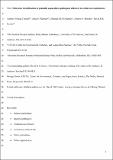Files in this item
Molecular identification of potential aquaculture pathogens adherent to cnidarian zooplankton
Item metadata
| dc.contributor.author | Clinton, Morag | |
| dc.contributor.author | Kintner, Anna Helen | |
| dc.contributor.author | Delannoy, Christian | |
| dc.contributor.author | Brierley, Andrew Stuart | |
| dc.contributor.author | Ferrier, David Ellard Keith | |
| dc.date.accessioned | 2020-12-07T15:55:17Z | |
| dc.date.available | 2020-12-07T15:55:17Z | |
| dc.date.issued | 2020-03-15 | |
| dc.identifier | 263958718 | |
| dc.identifier | 54cef08b-ca0c-4cee-8e4a-f36e50161dd3 | |
| dc.identifier | 85076032368 | |
| dc.identifier | 000510424900028 | |
| dc.identifier.citation | Clinton , M , Kintner , A H , Delannoy , C , Brierley , A S & Ferrier , D E K 2020 , ' Molecular identification of potential aquaculture pathogens adherent to cnidarian zooplankton ' , Aquaculture , vol. 518 , 734801 . https://doi.org/10.1016/j.aquaculture.2019.734801 | en |
| dc.identifier.issn | 0044-8486 | |
| dc.identifier.other | ORCID: /0000-0003-3247-6233/work/65702345 | |
| dc.identifier.other | ORCID: /0000-0002-6438-6892/work/65702537 | |
| dc.identifier.uri | https://hdl.handle.net/10023/21078 | |
| dc.description | Funding: Marine Alliance for Science and Technology Small Grant scheme, the University of St Andrews Russell Trust Award, and Marine Harvest Ltd. MC was funded by a BBSRC EASTBIO studentship and AK was funded by a MASTS Prize studentship. | en |
| dc.description.abstract | Cnidarian jellyfish are pest species of marine aquaculture, with their acute impacts well documented in farmed fish, particularly affecting the delicate gill tissue. Less is known about subsequent consequences of exposure, including their association with secondary bacterial infections. The aim of this study was to identify whether potentially pathogenic bacteria were present as part of the adherent microbial populations of three medusozoan jellyfish species; Obelia geniculata, Neoturris pileata and the Lion's Mane jellyfish Cyanea capillata. A number of potential pathogens of commercial aquaculture were identified, including Aeromonas salmonicida, Vibrio splendidus and Vibrio alginolyticus. These findings suggest that jellyfish must be considered not just agents of direct trauma to fish in aquaculture, but also potential reservoirs and vectors of bacterial disease. Since jellyfish may be increasing in the coastal waters where marine aquaculture occurs, the role of jellyfish in bacterial outbreaks has implications for marine aquaculture globally. | |
| dc.format.extent | 8 | |
| dc.format.extent | 11342529 | |
| dc.language.iso | eng | |
| dc.relation.ispartof | Aquaculture | en |
| dc.subject | Salmon mariculture | en |
| dc.subject | Bacterial pathogens | en |
| dc.subject | Cnidarian microbiome | en |
| dc.subject | Aeromonas salmonicida | en |
| dc.subject | Vibrio splendidus | en |
| dc.subject | Vibrio alginolyticus | en |
| dc.subject | QH301 Biology | en |
| dc.subject | SH Aquaculture. Fisheries. Angling | en |
| dc.subject | NDAS | en |
| dc.subject | SDG 14 - Life Below Water | en |
| dc.subject.lcc | QH301 | en |
| dc.subject.lcc | SH | en |
| dc.title | Molecular identification of potential aquaculture pathogens adherent to cnidarian zooplankton | en |
| dc.type | Journal article | en |
| dc.contributor.institution | University of St Andrews. Pelagic Ecology Research Group | en |
| dc.contributor.institution | University of St Andrews. School of Biology | en |
| dc.contributor.institution | University of St Andrews. Centre for Biophotonics | en |
| dc.contributor.institution | University of St Andrews. Scottish Oceans Institute | en |
| dc.contributor.institution | University of St Andrews. Marine Alliance for Science & Technology Scotland | en |
| dc.contributor.institution | University of St Andrews. Centre for Research into Ecological & Environmental Modelling | en |
| dc.identifier.doi | 10.1016/j.aquaculture.2019.734801 | |
| dc.description.status | Peer reviewed | en |
| dc.date.embargoedUntil | 2020-12-03 |
This item appears in the following Collection(s)
Items in the St Andrews Research Repository are protected by copyright, with all rights reserved, unless otherwise indicated.

